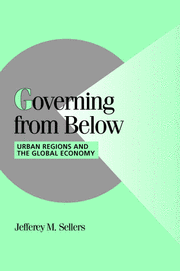2 - POSTINDUSTRIAL TRANSFORMATION AND THE SERVICE CITY
Published online by Cambridge University Press: 14 January 2010
Summary
As services, consumption and technology have grown to predominance in advanced industrial societies, a distinctive type of city has emerged. Far more than the market towns of medieval and early modern Europe, it operates as a node in vast networks of translocal markets, organizations, communications and distribution. In place of the smokestacks and tenements that dominated the skyline of nineteenth- and early-twentieth-century manufacturing cities, office towers, university campuses, business parks and shopping facilities now mark these metropolitan landscapes. In earlier urban service centers professionals, administrators and students seldom made up more than a small fraction of the total population. In contemporary service centers these groups often comprise the biggest single segment of local workforces, electorates and markets. Many such cities have sprung from localities where the industrial revolution left few traces. Others stem from the postindustrial metamorphoses of an urban economy long dominated by traditional manufacturing. Whatever its starting point, however, the transformation of urban service centers in advanced industrial societies has departed in crucial ways from parallel changes occurring in the biggest urban centers. Within as well as among France, Germany and the United States the variety of outcomes from this transformation manifests the significance of local conditions and local choices.
The extent and character of local growth, the evolution of environmental conditions and the degree of social and territorial polarization in the eleven urban regions provide indispensable data for understanding the consequences of policy. To lay the groundwork for subsequent analysis, this chapter considers these manifestations of policies and market strategies.
- Type
- Chapter
- Information
- Governing from BelowUrban Regions and the Global Economy, pp. 37 - 89Publisher: Cambridge University PressPrint publication year: 2002

